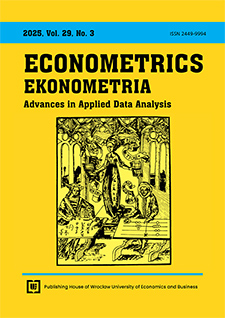The Cumulative Residual Entropy in Assessing the Duration of Unemployment
DOI:
https://doi.org/10.15611/eada.2025.3.02Keywords:
entropy, survival analysis, exponential distribution, unemploymentAbstract
Aim: The aim of the article was to use cumulative residual entropy (CRE) to assess the informational value of data on deregistration from the Poviat Labour Office in Szczecin (Poland) from 2007 to 2024. The events of declining cooperation with the labour office and starting work were analysed.
Methodology: The study used survival analysis methods with the assumption of an exponential distribution of duration. The CRE was calculated for the specified distribution parameters. Hierarchical clustering was used to identify clusters of years with similar CRE values. Using the dynamic time warping method, the CRE time series and the unemployment rate were compared.
Results: The study revealed a similarity between the registered unemployment rate and the development of entropy of unemployment duration. High unemployment rates corresponded to high entropy values, and vice versa. During periods of shock (caused by crises) in the labour market, the CRE for both reasons for deregistration took on extreme values.
Implications and recommendations: Analyses related to the duration in unemployment are more informative when the unemployment rate is lower. The labour market, as a system, is then characterised by less uncertainty.
Originality/value: There is a lack of research on the application of entropy by using survival analysis in studies regarding the labour market. The study took into account the relationship between the hazard value and the CRE for the exponential duration distribution.
Downloads
References
Aalen, O. O., Borgan Ø., & Gjessing H. K.(2008). Survival and event history analysis: A process point of view. Springer.
Abbasnejad, M., Arghami, N. R., Morgenthaler, S., & Borzadaran, G. M. (2010). On the dynamic survival entropy. Statistics & Probability Letters, 80(23-24), 1962-1971. https://doi.org/10.1016/j.spl.2010.08.026
Basha, L., & Gjika, E. (2022). Accelerated failure time models in analyzing duration of employment. Journal of Physics: Conference Series, 2287, 012014. https://doi.org/10.1088/1742-6596/2287/1/012014
Bieszk-Stolorz, B. (2017a). Funkcja skumulowanej częstości i modele hazardu w ocenie konkurujących form wyjścia z bezrobocia. Prace Naukowe Uniwersytetu Ekonomicznego we Wrocławiu. Research Papers of Wrocław University of Economics, 469, 21-31. https://doi.org/10.15611/pn.2017.469.02
Bieszk-Stolorz, B. (2017b). Cumulative Incidence Function in Studies on the Duration of the Unemployment Exit Process. Folia Oeconomica Stetinensia, 17(1), 138-150. https://doi.org/10.1515/foli-2017-0011
Bieszk-Stolorz, B. (2019). The Modified Lunn-McNeil Model in the Assessment of Intensity of Exiting from Unemployment. Econometrics. Ekonometria. Advances in Applied Data Analysis, 23(1), 77-89. https://doi.org/10.15611/eada.2019.1.06
Bieszk-Stolorz, B. (2025a). Entropy in the Assessment of the Labour Market Situation in the Context of the Survival Analysis Methods. Entropy, 27(7), 665. https://doi.org/10.3390/e27070665
Bieszk-Stolorz, B. (2025b). Relationship Between Coefficients in Parametric Survival Models for Exponentially Distributed Survival Time─Registered Unemployment in Poland. Econometrics, 13(1), 1. https://doi.org/10.3390/econometrics13010001
Charrad, M., Ghazzali, N., Boiteau, V., & Niknafs, A. (2014). NbClust: An R Package for Determining the Relevant Number of Clusters in a Data Set. Journal of Statistical Software, 61(6), 1-36. https://doi.org/10.18637/jss.v061.i06
Di Crescenzo, A., & Paolillo, L. (2021). Analysis and applications of the residual varentropy of random lifetimes. Probability in the Engineering and Informational Sciences, 35(3), 680-698. https://doi.org/10.1017/S0269964820000133
Di Crescenzo, A., & Toomaj, A. (2015). Extension of the past lifetime and its connection to the cumulative entropy. Journal of Applied Probability, 52(4), 1156-1174. https://doi.org/10.1239/jap/1450802759
Ebrahimi, N. (1996). How to Measure Uncertainty in the Residual Life Time Distribution. The Indian Journal of Statistics, Series A (1961-2002), 58(1), 48-56.
Ebrahimi, N., & Pellerey, F. (1995). New partial ordering of survival functions based on the notion of uncertainty. Journal of Applied Probability, 32(1), 202-211. https://doi.org/10.2307/3214930
Fernandez, O. E., & Beltrán-Sánchez, H. (2015). The entropy of the life table: A reappraisal. Theoretical Population Biology, 104, 26-45. https://doi.org/10.1016/j.tpb.2015.07.001
Gross, A. J. (1995). Applications in Survival Analysis. In: K. Balakrishnan, & A. P. Basu (Eds.), Exponential distribution: Theory, methods and applications (pp. 498-508). Gordon and Breach.
Güell, M., & Lafuente, C. (2022). Revisiting the determinants of unemployment duration: Variance decomposition à la ABS in Spain. Labour Economics, 78, 102233. https://doi.org/10.1016/j.labeco.2022.102233
Hill, G. (1993). The entropy of the survival curve: An alternative measure. Canadian Studies in Population, 20(1), 43-57. https://doi.org/10.25336/P6830H
Hooda, D. S., & Sharma, D. K. (2010). Exponential survival entropies and their properties. Advances in Mathematical Sciences and Applications, 20, 265-279.
Keyfitz, N. (1977). What difference would it make if cancer were eradicated? An examination of the Taeuber paradox. Demography, 14(4), 411-418.
Keyfitz, N., & Caswell, H. (2005). Applied Mathematical Demography. Springer.
Kleinbaum, D. G., & Klein, M. (2005). Survival analysis a self-learning text, 2nd ed. Springer.
Landmesser, J. (2009a). The survey of economic activity of people in rural areas-the analysis using the econometric hazard models. Acta Universitatis Lodziensis. Folia Oeconomica, 228, 385-392.
Landmesser, J. M. (2009b). Econometric analysis of unemployment duration using hazard models. Studia Ekonomiczne, 1-2(60-61), 79-92.
Markowicz, I. (2015). Duration analysis of firms–cohort tables and hazard function. International Journal of Business and Social Research, 5(11), 36-47.
Meyer, B. D. (1990). Unemployment Insurance and Unemployment Spells. Econometrica, 58(4), 757-782. https://doi.org/10.2307/2938349
Meyer, P., & Ponthière, G. (2020a). Human Lifetime Entropy in a Historical Perspective (1750-2014). Cliometrica, 14, 129-167. https://doi.org/10.1007/s11698-019-00185-y
Meyer, P., & Ponthiere, G. (2020b). Threshold ages for the relation between lifetime entropy and mortality risk. Mathematical Social Sciences, 108, 1-7. https://doi.org/10.1016/j.mathsocsci.2020.07.004
Montaseri, M., Charati, J. Y., & Espahbodi, F. (2016). Application of Parametric Models to a Survival Analysis of Hemodialysis Patients. Nephro-Urology Monthly, 8(6), e28738. https://doi.org/10.5812/numonthly.28738
Olbryś, J. (2022). Entropy-Based Applications in Economics, Finance, and Management. Entropy, 24(1), 1468. https://doi.org/10.3390/e24101468
Pierce, J. R. (1980). An introduction to information theory: Symbols, signals & noise. Dover Publications.
Putek-Szeląg, E., & Gdakowicz A. (2021). Application of Duration Analysis Methods in the Study of the Exit of a Real Estate Sale Offer from the Offer Database System. In: K. Jajuga, K. Najman, & M. Walesiak (Eds.), Data Analysis and Classification. Methods and Applications (pp. 153-169). Springer. https://doi.org/10.1007/978-3-030-75190-6_10
R Core Team (2025). R: A Language and Environment for Statistical Computing; R Foundation for Statistical Computing; Vienna, Austria. Retrieved from https://www.R-project.org
Rao, M., Chen, Y., Vemuri, B. C., & Wang, F. (2004). Cumulative residual entropy: a new measure of information. IEEE Transactions on Information Theory, 50(6), 1220-1228. https://doi.org/10.1109/TIT.2004.828057
Rezaei, R., & Yari, G. (2021). Keyfitz entropy: Investigating some mathematical properties and its application for estimating survival function in a life table. Mathematical Sciences, 15(3), 229-240. https://doi.org/10.1007/s40096-020-00354-5
Sączewska-Piotrowska, A. (2015). Poverty duration of households of the self¬employed. Econometrics. Ekonometria, 1(47), 44-55. https://doi.org/10.15611/ekt.2015.1.03
Shannon, C. E. (1948a). A mathematical theory of communication. The Bell System Technical Journal, 27(3), 379-432. https://doi.org/10.1002/j.1538-7305.1948.tb01338.x
Shannon, C. E. (1948b). A mathematical theory of communication. The Bell System Technical Journal, 27(4), 623-656. https://doi.org/10.1002/j.1538-7305.1948.tb00917.x
Shrahili, M., El-Saeed, A. R., Hassan, A. S., Elbatal, I., & Elgarhy, M. (2022). Estimation of Entropy for Log-Logistic Distribution under Progressive Type II Censoring. Journal of Nanomaterials, 2022, 2739606. https://doi.org/10.1155/2022/2739606
Stevenson, M. (2007). An introduction to survival analysis. EpiCentre, IVABS.
Wang, F., Vemuri, B. C., Rao, M., & Chen, Y. (2003). A New & Robust Information Theoretic Measure and Its Application to Image Alignment. In: C. Taylor, & J. A. Noble (Eds.), Information Processing in Medical Imaging. IPMI 2003. Lecture Notes in Computer Science (Vol. 2732, pp. 388-400). Springer. https://doi.org/10.1007/978-3-540-45087-0_33
Ward, J. H. (1963). Hierarchical Grouping to Optimize an Objective Function. Journal of the American Statistical Association, 58(301), 236-244. https://doi.org/10.1080/01621459.1963.10500845
Wiener, N. (1965). Cybernetics or Control and Communication in the Animal and the Machine. MIT Press.
Wycinka, E. (2019). Competing risk models of default in the presence of early repayments. Econometrics. Ekonometria. Advances in Applied Data Analysis, 23(2), 99-120. https://doi.org/10.15611/eada.2019.2.07
Zhang, Z. (2016). Parametric regression model for survival data: Weibull regression model as an example. Annals of Translational Medicine, 4(24), 484. https://doi.org/10.21037/atm.2016.08.45
Zografos, K., & Nadarajah, S. (2005). Survival exponential entropies. IEEE transactions on information theory, 51(3), 1239-1246. https://doi.org/10.1109/TIT.2004.842772
Downloads
Published
Issue
Section
Categories
License
Copyright (c) 2025 Beata Bieszk-Stolorz

This work is licensed under a Creative Commons Attribution-ShareAlike 4.0 International License.
Accepted 2025-09-21
Published 2025-10-30









